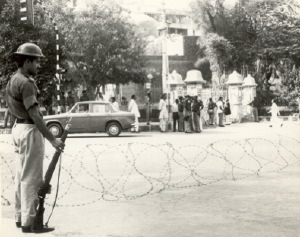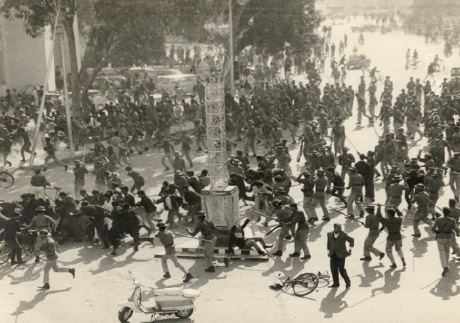The scenes we are seeing in the current lawyers movement for democracy, including the ones seen most recently at the Long March to Islamabad, reminds one that our memories are short but are struggles for democracy are not.
 These two news photographs from the F.E. Chaudhry of protests outside the Lahore High Court where Zulfiqar Ali Bhutto was being tried in 1978 are from about another set of protest for democracy by the intelligentia, outside another court, against another military dictator, and for democracy.
These two news photographs from the F.E. Chaudhry of protests outside the Lahore High Court where Zulfiqar Ali Bhutto was being tried in 1978 are from about another set of protest for democracy by the intelligentia, outside another court, against another military dictator, and for democracy.
These pictures are from an era when the suppression of information was stronger and technologies of liberation (like the electronic media, including blogs) were not widespread. One is not sure, therefore, if these pictures were ever actually published. But, looking at them today one is reminded of how little has changed either in the desire of ordinary Pakistanis for justice and democracy or in the response of the state to this desire. The barricades today are more sophisticated (containers have replaced barbed wire) but as the police danda is pretty much the same.
The first of the pictures above shows the chaotic scene of riot police quelling the protests on the Shahrahe-Quaid Azam, (or popularly the Mall Road) Lahore, by PPP loyalist who were trying to get to Lahore High Court, where Mr Bhutto was being tried for murder. It is strongly reminiscent of current lawyers struggle for the restoration of superior judiciary.
Presumably taken from a roof top of a building on the Mall, the long aerial shot establishes the scale of everlasting contest between oppressive organs of the state and the democratic forces of civil society, unsettling the democratic future of Pakistan. A testimony of resilience to democratic intelligentsia of the country, which has always struggled against military tyranny, but was rarely acknowledged.
A closer view of the photograph reveals the pockets of struggle within a wider frame. Brutal beating taken by the protestors at the hands of police, a cycle and a scooter abandoned in the middle of road, bare handed individuals failing to protect themselves from baton charged, while a civil officer calmly looks away as the havoc was a mundane state affair.
The second picture from FE Chaudhry shows a lone figure of a policeman on the Mall Road who stands calmly few blocks away, guarding the pillars of state. In the background are barbed wires, laid all around the Lahore High Court, with a posse of policemen trailing along the walls of the Court and their superiors blocking the entrance gate. The photograph captures the heavily guarded surroundings of the Lahore High Court, where Mr Bhutto was being tried for a murder.
These two pictures challenge the impression that Bhutto’s judicial murder was condoned by people in Pakistan. Or, the more recent argument that the current lawyers movement is something “new and unusual”, something “unnatural”, something “abnormal.”
Indeed, these two pictures validate Faiz Ahmed Faiz’s memorable lines (and also the poetic inspirations of Faraz and Jalib):
Yuhin hamesha ulajhati rahi hai zulm se khalq
Na unki rasm nai hai, na apni reet nai
Yuhin hamesha khilaye hain humne aag mein phool
Na unki haar nai hai na apni jeet nai
Click here for the evolving F.E. Choudhry Gallery at ATP.




















































@Richard Rai
The Guard dog became an unwanted owner of the house, he is supposed to protect the sheep not rule them………
Actually by and large no one came out to protest for Bhutto. No one really was willing to get beaten up for a man like him. I think Zia ul Haq did a great favour to Pakistan by ridding the country of Bhutto, just like Musharraf has done a great favor.
These are historic photos. Thanks for sharing them. Dias time was the darkest and most evil in our history and this period was the darkest and most evil of the Zia days.
Everyone talks about saving the country from something. 60 plus years later no one party which was elected by landslide were able to do anything about the country but they pushed her deeper toward destruction. Today once again we see that same old nara(slogan) that Musharf must go for the safety of the Country. The reality is this that these wolves would like the gurad dog to go or die so that they could destroy poor sheep of Pakistani public. So Pakistanioo open your eyes and watch out for these wolves. These things will happen over and over again.
And poor hope will be eluding all.
That is a memorable photograph. YOu are right there is very little record left of the agitation at that time because it was clamped down so heavily and because we did not have the news means to keep the news alive.
I guess the venom and hatred that some people spew at GEO is because they insist in showing the reality and the pictures on the screen and dictators cannot deny that reality. I imagine that without the media, and yes including the blogs, Musharraf and the ISI would have “wrapped up” this movement long ago… put some people in jail, make a few disappear, kill a few here and there, and then tell the rest of the country “sabb acha hai.”
Its the same with this long march. The sea of people was there for all to see. Yet there are some who keep insisting that it was nothing, no one was there, no one showed up. I wonder whether these propagandists are trying to fool the rest of us or are fooled themselves. I suspect it is the second!